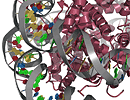Quantitative test of statistical positioning
Wolfram Möbius, Ulrich Gerland
Within the last five years, knowledge about nucleosome organization on the genome has grown dramatically. To a large extent this has been achieved by an increasing number of experimental studies determining nucleosome positions at high resolution over entire genomes. Particular attention has been paid to promoter regions, where a canonical pattern has been established: a nucleosome free region with pronounced adjacent oscillations in the nucleosome density. In our study, we tested to what extent this pattern may be quantitatively described by a minimal physical model, a one-dimensional gas of impenetrable particles, commonly referred to as the “Tonks gas”.
In this model, density oscillations occur close to a boundary at dense packing. Our systematic quantitative analysis reveals that, in an average over many promoters, a Tonks gas model can indeed account for the nucleosome organization to both sides of the nucleosome free region, if one allows for different boundary conditions at the two edges: On the downstream side, a single nucleosome is typically directly positioned such that it forms an obstacle for the neighboring nucleosomes, while such a barrier nucleosome is typically missing on the upstream side.


